CUSCO – CULTURE AND CUSTOMS
Cusco is a land full of customs and cultural manifestations of various kinds. For example, their dances, their festivities, crafts, religious festivals, gastronomy or the Quechua language itself, inherited from their Inca ancestors. Every corner of its territory has something to show the visitor. That is why, in addition to Machu Picchu, Cusco is one of the most visited tourist attractions in Peru. There is so much to know!
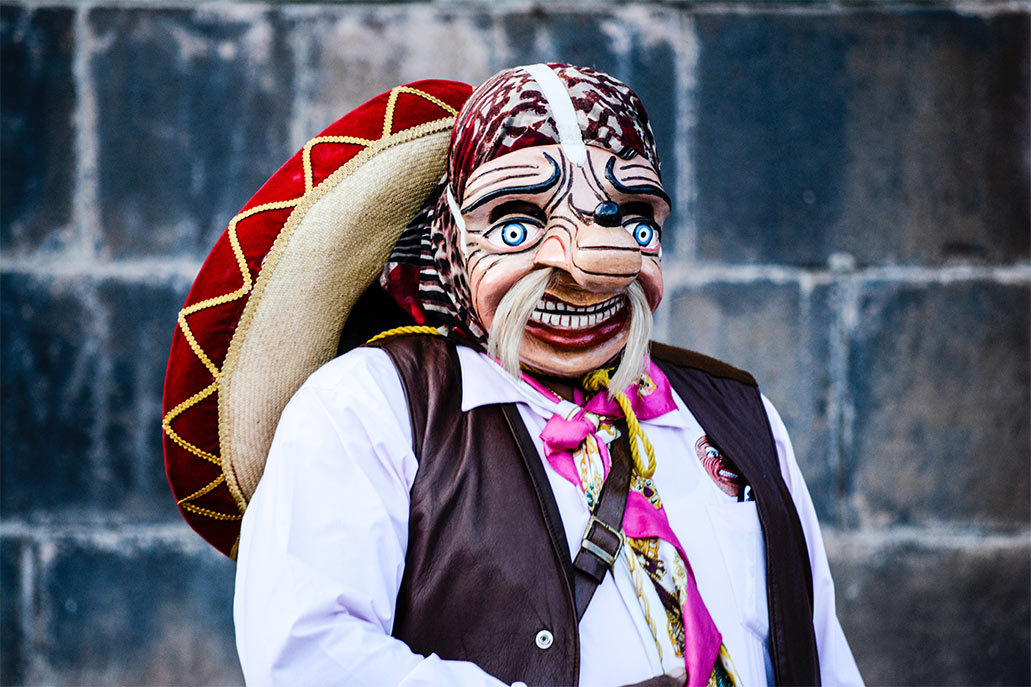
Content
Folklore in Cusco
Cusco has dances, music, festivities, crafts and all kinds of folklore from the Inca, colonial tradition and more. For example, the famous ‘Fiesta del Inti Raymi’ is a tradition dating back to Inca times. The religious festival of ‘Corpus Christi’ comes from the Christian colonial tradition. Likewise, many of the Cusco dances have their origin in the Republican era.
Inca Cusco
- Cusco, after more than 500 years since Inca times, maintains many of the traditions inherited by its ancestors.
- The main cultural legacy that the Incas left to the people of Cusco is the language. Quechua (known as ‘Runa Simi’) is still spoken by most of the inhabitants of Cusco. In many cases it is the mother tongue.
- The people of Cusco also inherited the feeding system of the Incas. For example, the technique of dehydration of meat and potatoes is still used today.
- In addition, the people of Cusco keep the use of plants and herbs to cure their daily ailments: the coca leaf, for example, is widely used to preserve resistance during agricultural work.
- In some towns of Cusco, community agricultural work is still carried out, just as the Incas did with the ‘minka’ and ‘ayni’ system.
- One of the Inca festivities that has survived the passing of time is the ‘Inti Raymi’ (Festival of the Sun). This religious ceremony was performed by the Incas in honor of the sun since 1535. Today, the people of Cusco celebrate it with a monumental staging in 3 historical settings: the temples of Sacsayhuaman, Coricancha and the city’s main square.
Colonial Cusco
- During colonial times, the Spanish imposed Christianity with great force and even violence. Today, Cusco is one of the most religious towns in Peru. There are many Christian traditions practiced with fervor in the ancient Inca capital.
- The feast to the Lord of the Earthquakes (Patron sworn of Cusco) has been celebrated with great faith since 1650, when an earthquake destroyed the city. The townspeople brought out the image of this dark-skinned crucified Christ in procession in order to appease the strong movements.
- Corpus Christi is another of the religious celebrations from the colonial tradition. It was imposed by Viceroy Francisco de Toledo in 1572 to replace the custom of bringing out the mummies of former Inca rulers in procession.
- The feast of the Lord of Qoyllur Rit’i is another of the colonial festivities that are celebrated with more religiosity today. It is a pilgrimage more than 4 thousand meters high (13,123 ft) to the Temple of Qoyllur Rit’i, at the foot of the snow-capped Ausangate.
- In addition to Christianity, the colonial era left Cusco: the Spanish language, painting, sculpture, architecture, gastronomy and more. Today, the folklore of Cusco is mainly a combination of the Inca with the colonial tradition.
Modern Cusco
- Cusco also has its own folklore that were not taken from the Inca or colonial traditions. Some of the most popular modern cultural manifestations are carnivals, music and dances.
- The Cusco carnivals were a tradition brought by the Spanish but it took on its own characteristics over the years. Today, it is celebrated with dance, music and hubbub. It is customary for men and women to play with water during carnivals.
- Cusco music has its roots in Inca and colonial times. However, it acquired its own characteristics over time. Today, the most widespread musical genre is the huayno (Andean music mainly characteristic of Peru). The most used instruments are the guitar, the charango, the zampoña, the quena and more.
- Most of the dances of Cusco have a colonial origin although they also represent the folklore of the Inca and Republican times. Today, the most characteristic dances of Cusco are the carnivals. These represent the hubbub of each town during the carnival celebrations. Some of the most popular dances in Cusco are: the Ampay carnival, Cusco carnival, Ccatcca carnival, Sullumayo carnival and more.
Dances in Cusco
Cusco is the department of Peru with the most dances. Most traditional festivities include dance choreographies that are liked by the population. Most of the dances have been practiced since the Republican era and represent scenes from the colonial era and even the Inca era. The clothes are representative of each region of Cusco. In addition, music with traditional instruments is used. Most of the dances are performed in honor of the virgins and saints of each town. The dance and choreography can last several hours and even days.
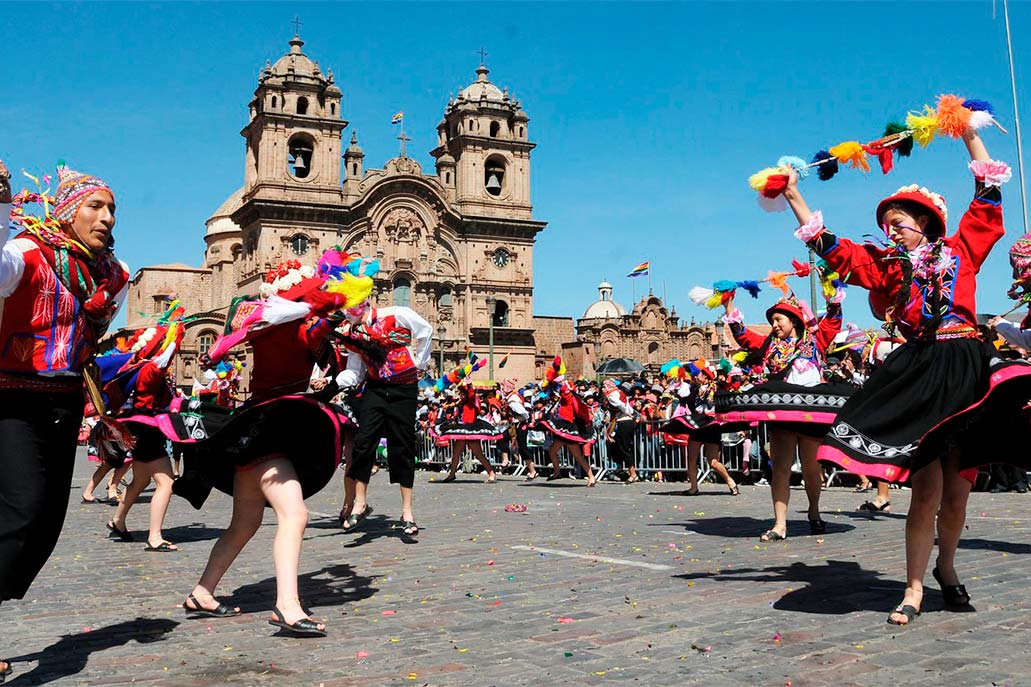
Cusco Carnival
- The Cusco carnival is the manifestation of carnival joy celebrated in the city. It is characterized by the use of streamer and water during celebrations. In the middle of the dance, the traditional dance is performed around a tree. The women wear a white outfit with a colorful skirt. The men wear trousers and a vest. The dance is characterized by the joy and flirtation between women and men.
The goldfinches
- Goldfinches are characteristic birds of the Andean area whose main characteristic is the tenderness of their song. This is how this dance, native to the province of Calca, is characterized by tender music and the gentle movements of the goldfinch. The dress is colorful and festive.
Turkuy
- The dance represents the agricultural work carried out by the inhabitants of the town of Yanahoca in the province of Canas. The women wear colorful skirts as well as the characteristic waracas with pompoms from Cusco. The men, pants, shirts, vests and some kind of skirts of fine white fabric. The songs of both are in the Quechua language.
Ampay Carnival
- Like all carnivals, the steps and choreography of the dance are festive. Both men and women wear multi-colored suits and sing songs in Quechua. The men’s and women’s suits are full of flowers and multi-colored pompoms. The dance is native to the town of Ampay in the province of Calca.
Ccatcca Carnival
- This dance is characterized by the joy and color of the dance steps. It represents the cult of the mountains and the earth. The women’s suit is with a multicolored skirt. The men’s clothing stands out for their huge pompous woolen hats. The dance comes from the district of Ccatcca in the province of Quispicanchis, Cusco.
Solischallay
- It is characterized by the joy and gallantry of single men and women during the courtship of infatuation. The dance includes songs and music in Quechua. The men wear multicolored pants and vests. Women; skirt, vest and hat. The dance originates from the town of Tinta in the province of Canchis, Cusco.
Q’ara Takay
- The dance recreates the community meeting to celebrate the distribution of camelid leather (believed to have its origins in Inca times). The men and women wear colorful suits where chullos, flip flops and skirts stand out. The dance comes from the district of Pitumarca in the province of Canchis, Cusco.
Saras Pillu
- The dance of Saras Pillu (‘Corn hair’, in Quechua) represents a ritual in honor of the rain. Men fight each other with lashes in homage to the earth. The women wear skirts and hats. The men pants, vests and a shirt with some species of wings. The dance originates from the Laq’o community in the province of Quispicanchis, Cusco.
Qasqa Kio
- The name of this dance is due to the bird ‘Kio’, which symbolizes the fertility of the lands. The steps are joyful and festive. The women wear colorful skirts and green hats. The men’s flip flops, shorts and yellow hats. The dance originates from the Laq’o community in Quispicanchis, Cusco.
Sullumayo Carnival
- Dance that represents the hubbub of the settlers who go to the town of Huaro to celebrate and cultivate the land. The choreography depicts men courting women. The sheepskins that adorn the heads of the men stand out. The women wear their characteristic skirts as well as flip flops and llicllas. The dance belongs to the Sullumayo community, in the province of Quispicanchis, Cusco.
Quechua, the language of the Incas
Quechua is the most widely spoken native language in South America. It is currently spoken in up to 7 countries: Peru, Ecuador and part of Bolivia, Argentina, Chile and Colombia. Its origin dates back to the Caral valley in the 3,000 years before the Christian era. The language is expanded throughout the Andes Mountains until it was recognized as the official language of the Inca Empire in the 15th century of the Christian era. The Spanish tried in vain to ban the Quechua language after the conquest. Today in Cusco, most people speak Quechua over Spanish. It is estimated that about ten million people speak Quechua. In Peru, this average has increased in recent years.
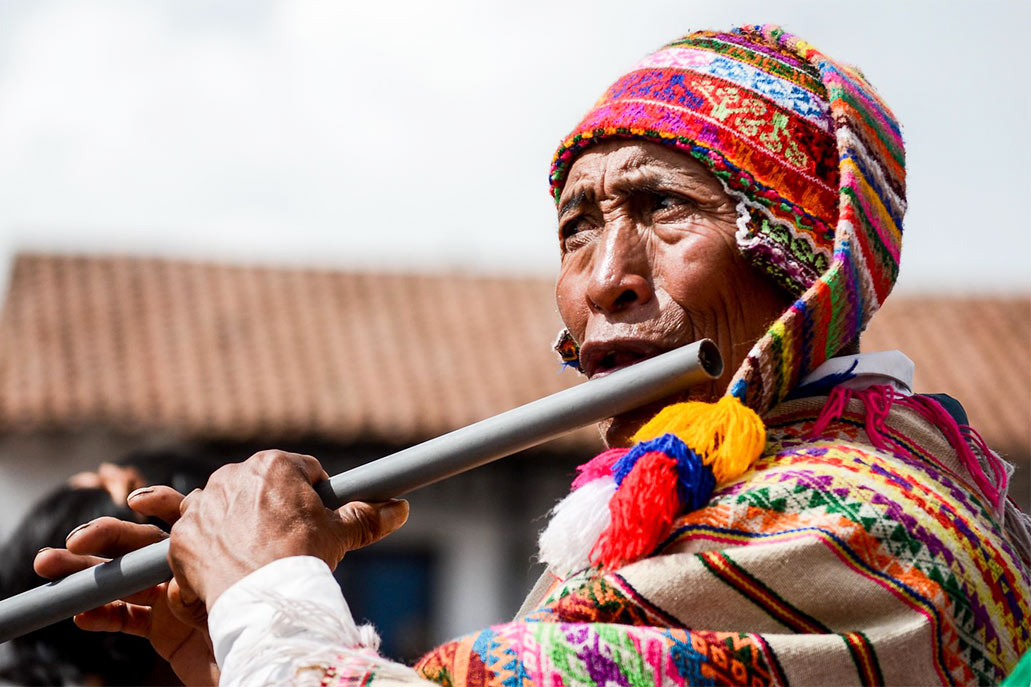
The origins of Quechua
- There are various hypotheses about the origin of the Quechua language in the continent. The most widely accepted is that it originated in the central coast of present-day Peru, in the ‘Caral’ culture, known as the oldest in America (in 3,000 BC).
- The residents of Caral traded with neighboring towns, expanding the language. Thus, over the years Quechua spread throughout the central Andes (current territories of Áncash, Cerro de Pasco, Junín, Huánuco and Lima).
- In the same way, after many years, Quechua spread throughout the northern territories (Cajamarca, Lambayeque, Amazonas, Ecuador, Colombia and Brazil) as well as the southern part of the continent (Apurímac, Ayacucho, Huancavelica, Arequipa, Puno , Bolivia, Argentina, Chile and Cusco).
Quechua during the Incas
- In Cusco, as in the north and center of the continent, Quechua acquired its own characteristics and development. Thus, when the Incas arrived with their own language (it is believed that Puquina), they found that many of the settled peoples of Cusco had Quechua as a language.
- The Incas managed to adapt to Quechua to the point that they adopted it as an official language and spread it throughout the empire. However, according to some researchers, the Inca nobility continued to use Puquina as a secret and exclusive language for the ruling class.
- The expansion of the Inca empire throughout the continent also brought with it the spread of the Quechua language in the conquered peoples. There were even other native languages that disappeared and gave way to Quechua.
Quechua during colonial times
- After the conquest of the Inca empire by the Spanish in 1532, the Quechua language was used by the evangelizers to indoctrinate the Indians, whether they are Quechua speakers or not.
- During the first years of the conquest, the Spanish had to learn the Quechua language in order to administer the new colony. For this they had Indian translators.
- Once Spanish power was secured in Cusco, the Indians were forced to learn Spanish in a practical way (with daily contact).
- During the colony, mestizos (children of Spaniards and Indians) emerged who learned the Castilian language and Quechua. Some of the largest representatives in Cusco are: Guamán Poma de Ayala and the Inca Garcilaso de la Vega.
- Thus, during the colonial period, in Cusco Spanish (the new official language) and Quechua (the old Inca official language) coexisted. However, a large majority of the population kept Quechua as their mother tongue.
Quechua in literature
- Since before the arrival of the Spanish, the Incas developed an oral literature that was later put on paper in the Spanish language.
- This is how the ‘Legend of the Ayar brothers’ or the ‘Legend of Manco Cápac and Mama Ocllo’ became known, which sought to give a mythological origin to the Incas.
- During the Spanish conquest, the chroniclers Human Poma de Ayala and the Inca Garcilaso de la Vega described the history of the Incas and the conquest through their chronicles.
- Likewise, during the colonial period, the bible was translated into Quechua. Thus, the evangelizers managed to spread the Christian religion among the indigenous people.
Quechua today
- Currently, Quechua continues to be a very widespread language in Cusco as well as in the Andean peoples of Peru and South America.
- In 2017, 3,805,531 people who speak Quechua as their mother tongue were registered in Peru. This means an increase over previous years.
- Quechua continues to be the main language in Cusco (it is estimated that more than 1 million people speak it). Likewise, there are 2 other types of Quechua in Peru: Ayacucho Quechua and Ancashino Quechua.
- In addition to Cusco, Quechua is spoken in: Arequipa, Puno, Moquegua, Apurímac, Huancavelica, Cajamarca, Junín, Lambayeque, Áncash, Ayacucho, Huánuco, Pasco and Lima.
Crafts in Cusco
Cusco is a land of artisans. For a long time, the people of Cusco produced important manifestations in textiles, painting, pottery, jewelry, wood carving, imagery, and much more. The neighborhood of San Blas, in the Historic Center of Cusco, was home to several of the best Cusco artisans such as: Manuel Olave, Hilario Mendívil, Domingo Álvarez and many others. Today, it is possible to buy good crafts in the famous markets of San Pedro, Pisac as well as in the same neighborhood of San Blas.
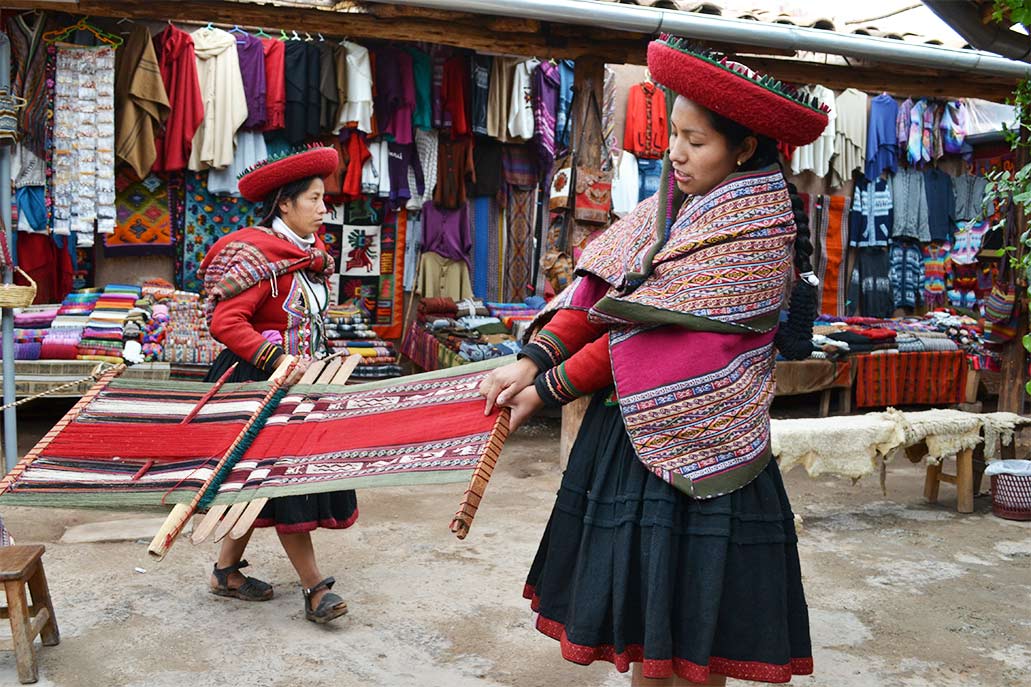
Textile in Cusco
- Textile is one of the most representative crafts in Cusco since, in most cases, they are made in a traditional way using natural products such as alpaca wool.
- The products most manufactured by the artisans are ponchos, chullos, scarves, blankets and llicllas (also used to transport babies on their backs). The textiles display zoomorphic ornaments representative of the Inca tradition.
- In Cusco, there are many textile centers where it is possible to appreciate the ancestral spinning process as well as the natural dyeing of the garments. Tourists can buy textile products in any market but especially in: Chinchero, Pisac and Calca.
Pottery in Cusco
- Cusco pottery uses some techniques inherited by the Incas hundreds of years ago. The motifs are also taken from the Inca tradition: geometric, zoomorphic and anthropomorphic figures.
- However, there is also a ceramic tradition based on tourist preferences. Thus, we can find ceramics with human and animal motifs and representations of Inca life.
- The main pottery workshops in Cusco are located in the towns of Raqchi, Pisac, and Urubamba. In the latter town is the workshop of the famous potter Ruiz Caro.
- Ceramic objects preferred by tourists are: glasses, crockery, bottle-shaped containers and ashtrays.
Jewelry in Cusco
- Cusco artisans in Pisac are famous for making a variety of jewelry based on silver and sometimes gold. The motifs are mostly Andean and Inca (llamas, vicuñas, tumis, chacanas, suns, moons, etc.).
- In Pisac there are workshops where you can see the jewelry manufacturing process. The most commonly used techniques are embossing and hammering.
- In addition to Pisac, the towns of Chinchero, Andahuaylillas and Urubamba offer fine gold and silver jewelry. In Cusco it is possible to visit the jewelry stores of the Centro Artesanal, located on Avenue El Sol.
Wood carving in Cusco
- The San Blas neighborhood is famous for hosting the best wood carvers in Cusco. The most popular works are the Andean altarpieces: rectangular boxes finely decorated with human and animal figures.
- In Cusco, the preferred materials for carving are cedar and mahogany. In addition to the altarpiece, Cusco artisans are famous for their ornamental balconies and Inca and zoomorphic figures. The techniques are inherited from the colonial era but the reasons are mainly Inca.
- Among the many carvers in Cusco, Mr. Domingo Álvarez stands out, whose workshop is located in the San Blas neighborhood.
Imaginary in Cusco
- Cusco is one of the most Catholic cities in Cusco. Among the most popular crafts with religious motifs are the various images and sculptures of saints and virgins.
- Thus, the children ‘Manuelitos’ (baby Jesus’ with Andean motifs) are famous, created by the famous craftsman Manuel Olave. Also famous are the ‘long neck’ saints and virgins created by the famous craftsman Hilario Mendívil.
- The main materials used in Cusco imagery are plaster, wood, clay and maguey. In addition, the representations of religious and Inca scenes are famous. Most artisans have their workshops in the San Blas neighborhood in Cusco.
Festivities in Cusco
Each year Cusco celebrates a variety of religious and Andean festivities. The Inti Raymi festival (Sun Festival) is an Inca tradition implanted by the Inca Pachacutec in approximately 1430 and that continues to be celebrated today by the people of Cusco. There are also other festivals of colonial origin, such as: El Señor de los Temblores, Holy Week, Corpus Christi, El Señor de Qoyllurriti and more.
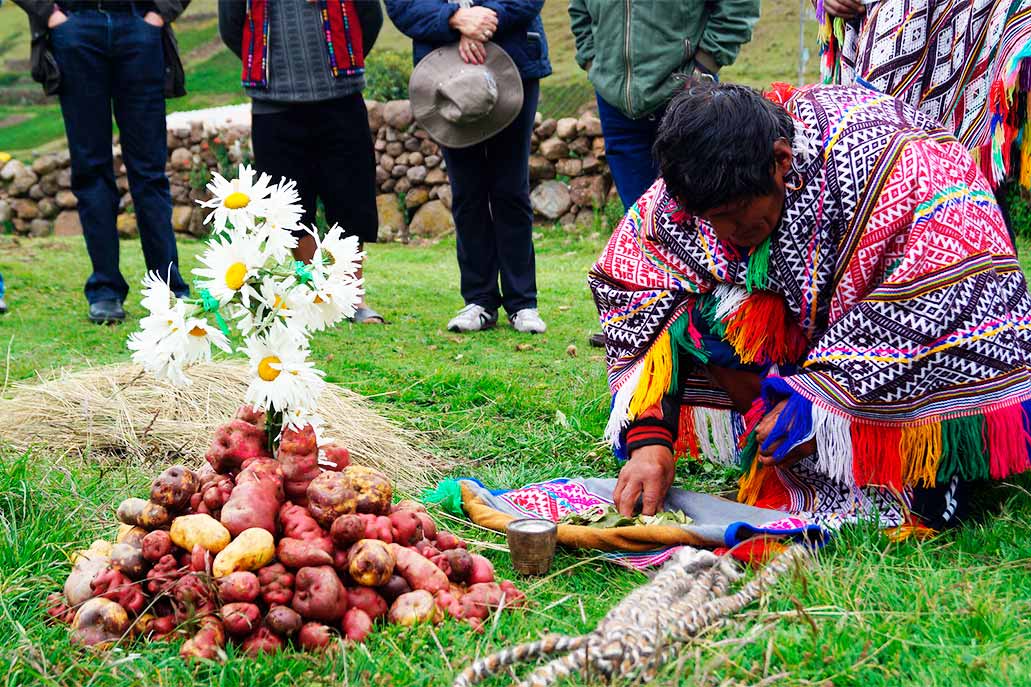
Know the calendar of the main festivities of Cusco:
Change of rods in Chinchero
- The ‘Varayoc’ is the leader of a community. This tradition has its origins in Inca times. Today, in Chinchero and other Cusco towns the tradition of the ‘Cambio de varas’ is carried out, which consists of delegating the position of Varayoc to a new person. This ceremony takes place every January 1.
Carnivals of Cusco
- Carnivals are a traditional festival in the world. In Cusco, as in many Andean regions of Peru, it is celebrated with dance, music and yunzas (trees decorated with gifts). It is also traditional for men and women to play with water and talcum powder. It is celebrated mainly in February.
Lord of Tremors
- The Lord of the Earthquakes is one of the main saints of the city of Cusco (he is considered a Jury Patron of Cusco). It is recognized for its black color. Its name comes from the fact that it was taken in procession in the 1650 earthquake. The religious festival in its honor is celebrated between the second half of March and the first week of April (every Holy Monday).
Holy Week in Cusco
- Holy Week is a religious holiday that commemorates the passion and death of Jesus Christ. In Cusco it is celebrated with great religious faith: the saints and virgins go out in procession. It is common to taste sweets and desserts. Cusco families usually eat ’12 different dishes ‘on Good Friday’. The date varies between March and April, according to the lunar calendar.
Lord of Qoyllurriti
- The Lord of Qoyllurriti is one of the most representative religious manifestations of Cusco. The image of this crucified Christ is venerated in the Sinakara sanctuary, at the foot of the snow-capped Ausangate, more than 4 thousand meters above sea level. Every year more than 10,000 faithful arrive there on pilgrimage from all over the Cusco region.
Corpus Christi
- Corpus Christi is a religious holiday that celebrates the Christian Eucharist (the sacrifice of the body and blood of Jesus Christ). In Cusco, this celebration is characterized by the processions of the 16 saints and virgins of the town, who meet in the city’s Cathedral. It is a tradition to eat ‘Chiriuchu’ (guinea pig baked with chicken, cheese and torreja of corn). The date is movable. It is celebrated 60 days after Easter.
Inti Raymi
- Inti Raymi is an Inca religious celebration in honor of the sun (its name means Festival of the Sun). It was established by the Inca Pachacutec in the 1430s. However, the Spanish prohibited it during the colony. Since 1944, the people of Cusco celebrate the Inti Raymi, every June 24, with a huge staging representing the Inca religious ceremony.
Pachamama Day
- The ‘Pachamama’ is the goddess or ‘Mother Earth’ for the Incas and many of the indigenous peoples hundreds of years ago. To revalue the importance of agricultural productivity, every August 1 is celebrated ‘Earth Day’. During that date, in Cusco the famous ‘Pagos a la tierra’ are made: a ritual in honor of the mountains and the land that has its origins since before the Incas.
Feast of All Saints
- The ‘Feast of All Saints’ is a Catholic holiday that commemorates the deceased. In Cusco this festival is characterized by the offerings that families make to their dead. Cemeteries are packed with people who sing, dance and toast in memory of their deceased. It is characteristic to eat the famous ‘Tanta wawa’ bread as well as other delicious dishes. It is celebrated every November 1.
Santuranticuy
- Santuranticuy is a Cusco festival that precedes Christian Christmas with the sale of saints, virgins and other Christian representations. From the early hours, the main square of the city fills with vendors of these Christian representations. The commercialization of candles, incense, flowers and more is also common. At night, Cusco families gather for Christmas dinner. It is celebrated every December 24th.
New Year in Cusco
- The New Year’s party has its own characteristics in Cusco. Families often get together to taste the delicious baked suckling pig. It is also characteristic to make the ‘Payments to the earth’ to receive the blessing of the ‘Pachamama’ (goddess of the earth). On the night of December 31, the main square of Cusco fills with people who carry out their cabal for the next year.
The Inti Raymi festival
The Inti Raymi Festival is one of the most famous Cusco celebrations in the world. It commemorates the ‘Wawa Inti Raymi’, the festival in honor of the sun established by the Inca Pachacutec in the 1430s. During the Spanish colony this religious festival was prohibited and fought against. In 1944, the people of Cusco organized a festival to commemorate their Inca ancestors and the Inti Raymi was created, a giant staging that evokes the Inca tradition.
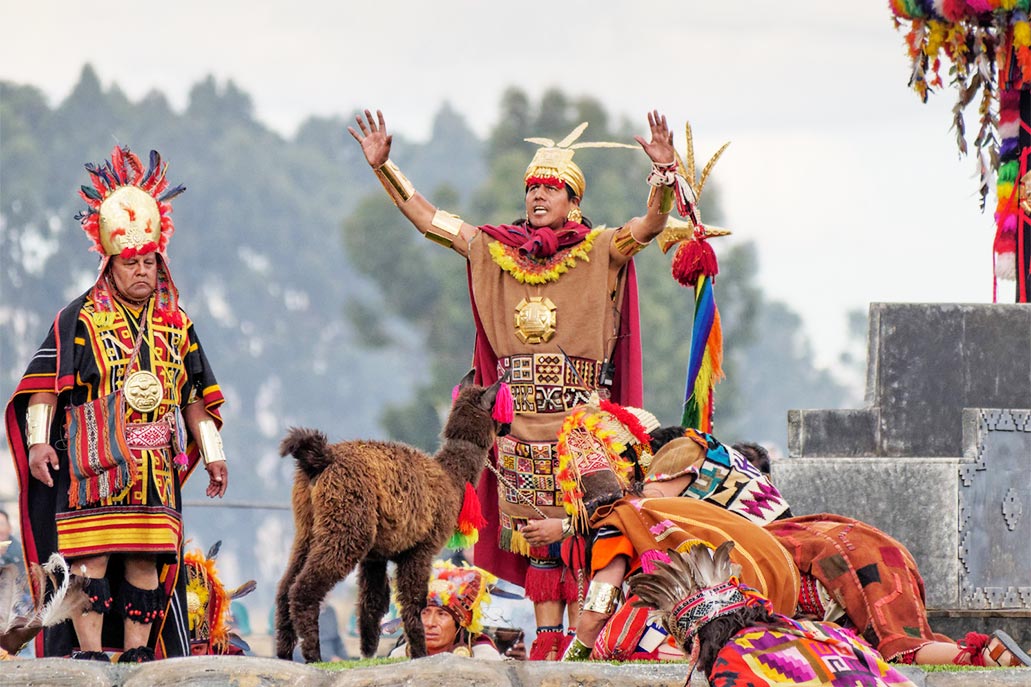
The Inti Raymi in the Inca Empire
- The Inca Pachacutec established the ceremony of the ‘Wawa Inti Raymi’ in the new empire with the religious and political purpose since it brought together the entire population including the representatives of the peoples furthest from the empire.
- The ‘Wawa Inti Raymi’ was celebrated every winter solstice as it represented the day when the sun moved farthest from Earth. For the Incas it represented the beginning of a new era.
- To celebrate the ‘Wawa Inti Raymi’, the Incas needed to fast several days before and even practiced sexual abstinence. It is said that in the whole city bonfires were not allowed.
- During the celebration of ‘Wawa Inti Raymi’, the Inca nobility received the first rays of the sun in the Coricancha temple. Then animal sacrifices and offerings to the sun were made in the current main square. These festivities were carried out with a crowd of approximately 100,000 people.
The prohibition of Inti Raymi
- After the Spanish conquest of the Incas, the celebration of the ‘Wawa Inti Raymi’ was allowed for some years. However, after a while, the Spanish saw their domination in jeopardy so they decided to ban it.
- The prohibition of the ‘Wawa Inti Raymi’ was not fulfilled by the Incas of Vilcabamba who continued celebrating this festival as it was done in ancient times in Cusco.
- However, the Incas of Vilcabamba were not the only ones who continued to celebrate the ‘Wawa Inti Raymi’. The Indian population continued to celebrate it in secret and behind the back of the Spanish who considered it a pagan festival.
- Over the years, the ‘Wawa Inti Raymi’ party was disappearing but not totally. According to some chronicles, during the ceremonies organized by the Spanish (Corpus Christi, Holy Week, etc); The Indians wore their Inca costumes and even performed ceremonies in the same way as they were performed in the ‘Wawa Inti Raymi’.
- However, these manifestations of the ancient ‘Wawa Inti Raymi’ became very sporadic due to the imposition of the Christian religion on the inhabitants of Cusco.
The Inti Raymi today
- In 1944, the artist and intellectual from Cusco Faustino Espinoza Navarro made a recreation of the ‘Wawa Inti Raymi’, according to the chronicles of the writer (also from Cusco) Garcilaso de la Vega.
- The objective was to favor the tourism sector in the city. For this, they decided to celebrate it in the same Inca scenarios of several centuries ago: the Coricancha, the main square as well as in the imposing Fortress of Sacsayhuaman . Over time, this ceremony was renamed Inti Raymi and became very popular with tourists and locals.
- Currently the Inti Raymi is celebrated every June 24 with the representation of the ceremonies performed by the Inca in homage to the sun. The staging has the participation of hundreds of actors and actresses from Cusco.
- The Inti Raymi became a revaluation of Cusco with its Inca ancestors. The festival also attracted a lot of interest from foreign tourists. That day is a non-working day for the Cusco population.
The carnivals of Cusco
Carnivals in Cusco are a series of celebrations full of joy, music and dance. The festival begins with the celebrations of the day of ‘the comadres’ and the day of ‘the compadres’ where it is tradition to taste the ‘timpu’ or puchero (broth full of meats and vegetables). It is also common to create burlesque rag dolls among friends or family. The central day is movable since it can be celebrated on a Sunday in February or March. Young people often play with water between men and women.
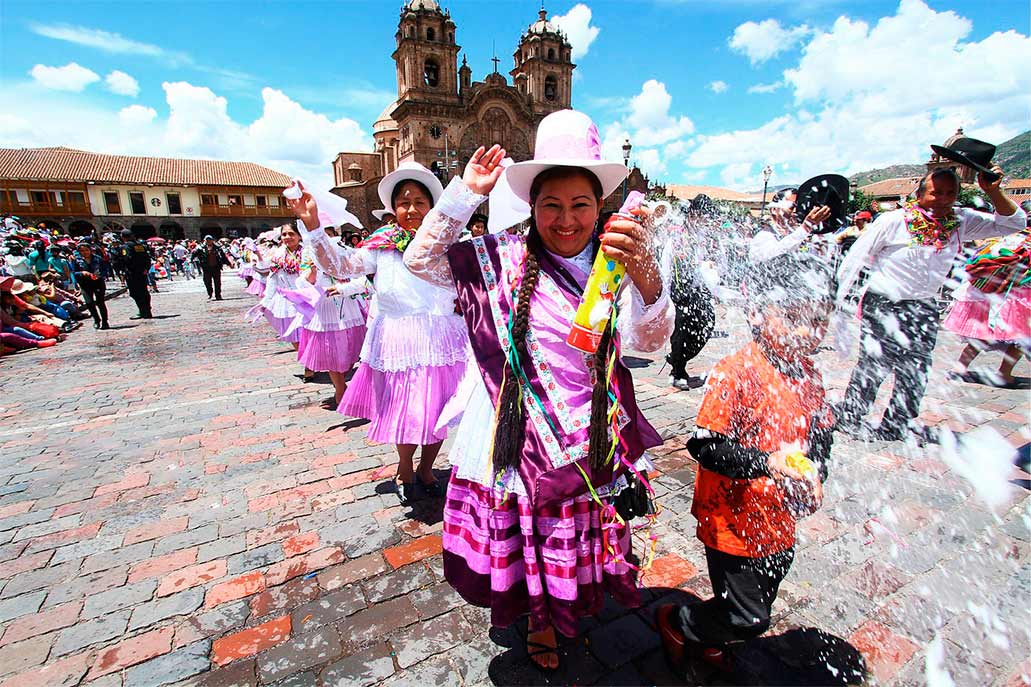
Feast of the ‘compadres’ and ‘comadres’
- The ‘compadres’ festival is a Cusco tradition in which women honor men with hugs and exquisite dishes such as ‘timpu’. However, as part of tradition, women often create rag dolls with burlesque or cartoonish allusions to men. This festival is celebrated two Thursdays before the central carnival Sunday.
- The feast of the ‘comadres’, like the feast of the compadres, is characterized by the tribute that men pay to the women of Cusco. For this they usually entertain them with typical dishes and other gifts. However, on that date it is also customary for men to create dolls with burlesque allusions to women. This celebration takes place on a Thursday before Carnival Sunday.
The carnivals of Cusco
- The central day of the carnivals in Cusco is usually movable (a Sunday between February and March) and varies from town to town in traditions.
- In the city of Cusco, for example, the rowdy game with water and foam performed by men and women in the main square and surrounding places is common.
- In the markets it is traditional to sell typical dishes such as ‘timpu’. In addition, the villagers usually celebrate carnivals as a family with music and dance.
- In the provinces of Cusco it is common to use ‘yunzas’, trees adorned with gifts and surprises for the attendees who dance and sing around them while trying to knock it down with a machete.
- The towns of the Sacred Valley of the Incas are famous for the joy of their carnivals. The most visited by tourists are the carnivals of Pisac, Calca, Chinchero, Urubamba, Lamay, Yanahuara and Ollantaytambo.
The ‘kacharpari’ or carnival auction
- The ‘Kacharpari’ is the ‘auction’ or simply the farewell to carnivals. It is characterized by the joy, music and festive dances that the population represents.
- In the city of Cusco, the parades of comparsas with dancers and musicians in the main square are characteristic.
- During ‘Kacharpari’ the use of ‘yunzas’ is more common. Because it is the last day of carnival festivities (until next year); joy is overflowing in all Cusco towns.
Corpus Christi in Cusco
‘Corpus Christi’ is the most important religious festival in Cusco. It is a massive event where the 15 most important saints and virgins of the city are carried in procession. These images are transferred to the Cathedral where they rest for 7 days until the ‘eighth’, where they are transferred back to their respective churches. Throughout the event, it is a tradition to taste the delicious ‘Chiriuchu’, a typical Cuy-based dish from Cusco.
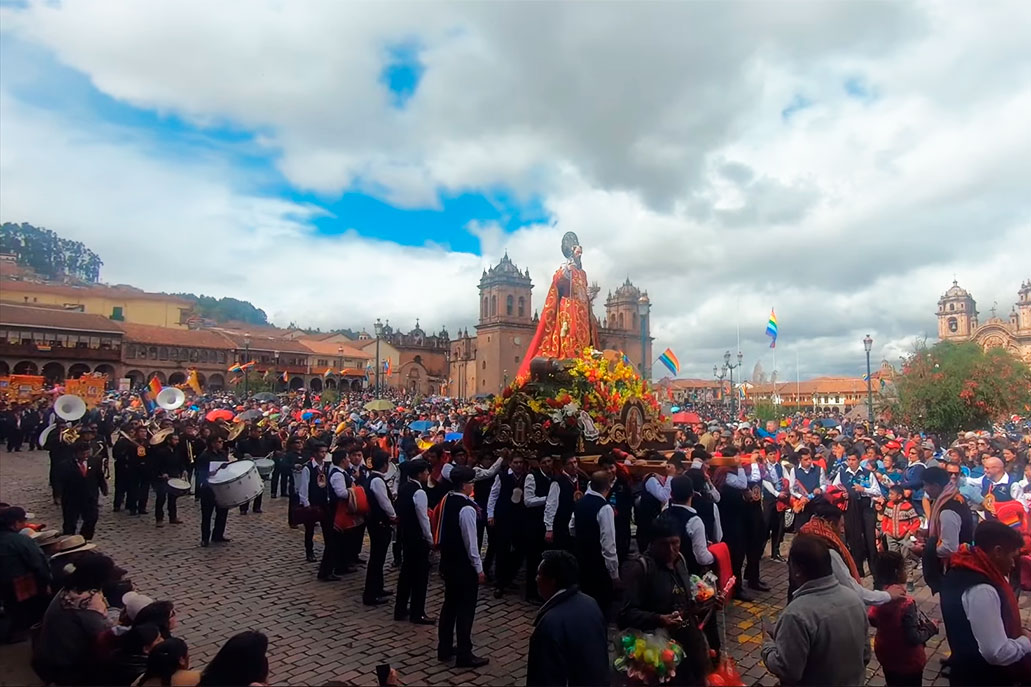
Origins of Corpus Christi
- Corpus Christi is a Christian holiday celebrated throughout the world to revalue the sacrifice of Jesus Christ on the cross.
- In Cusco this festival was implanted as a measure of the colony against the pagan tradition of walking the mummies of the former Inca rulers. Thus, the Spanish decided to change the Inca images for the new saints and virgins of the city.
- At first the indigenous people refused to worship these strange new figures. However, with the passage of time and Christian imposition, they ended up accepting the new religion and new customs.
- Today, Corpus Christi is a Christian holiday celebrated with great religiosity in Cusco. However, in its origins this festival had a markedly Inca character.
The central day of Corpus Christi
- The central day of Corpus Christi is variable. It is celebrated on the Thursday after the ‘Solemnity of the Holy Trinity’ (in June). In Cusco this date coincides with the celebrations for the city’s jubilee month.
- The day before Corpus Christi (Wednesday) the entrance and procession of the 15 images of saints and virgins of the city takes place in the direction of the Cathedral. Each image is accompanied by its group of parishioners as well as a musical band.
- On the main day of Corpus Christi, the main procession of 15 images takes place through the streets of Cusco. Then they will re-enter the Cathedral while the population tastes the traditional ‘Chiriuchu’ (a dish made from guinea pig, chicken, corn, cheese and more).
The 15 saints and virgins of Cusco
These are the 15 saints and virgins that are carried in procession during the Corpus Christi festivities of Cusco:
- Virgin of the Immaculate Conception (the ‘Linda’ of the Cathedral of Cusco).
- Virgin of Bethlehem (Parish of Bethlehem).
- Purified Virgin (Parish of San Pedro).
- Virgen de los Remedios (Church of Santa Catalina).
- Virgin of the Nativity (Almudena Parish).
- Santa Ana (Parish of Santa Ana).
- Santa Bárbara (Parish of the Poroy district).
- San José (Parish of Belén).
- San Pedro (Parish of San Pedro).
- Santiago Apóstol (Parish of Santiago).
- San Sebastián (Parish of the district of San Sebastián).
- San Blas (Parish of San Blas).
- San Cristóbal (Parroquia del San Cristóbal).
- San Jerónimo (Parish of the district of San Jerónimo).
- San Antonio (Parish of San Cristóbal).
The eighth or farewell to Corpus Christi
- Eight days after the main day of Corpus Christi, the saints and virgins are again taken in procession, although this time they return to their respective parish or church where they will remain until the next Corpus Christi the following year.
- During the eighth or farewell it is customary for parishioners to celebrate and celebrate in honor of the saint or virgin of their choice. The festival is characterized by the typical gastronomy of the region as well as the consumption of alcoholic beverages.
Qoyllur Rit’i, pilgrimage of the Andes
The Lord of Qoyllur Rit’i is a Christian religious festival but it has a very ancient Andean background: the relationship between man and nature. It takes place in the town of Mawayani, at the foot of the snow-capped Ausangate. Despite the extreme weather and the altitude at almost 5 thousand meters high (16,404 ft); the pilgrimage in honor of the image of Mr. Qoyllur Rit’i brings together more than 10,000 people from all over Cusco and beyond. The festival is characterized by dances, music and satirical representations of colonial origin. This festival is recognized by UNESCO as ‘Intangible Cultural Heritage of Humanity’.
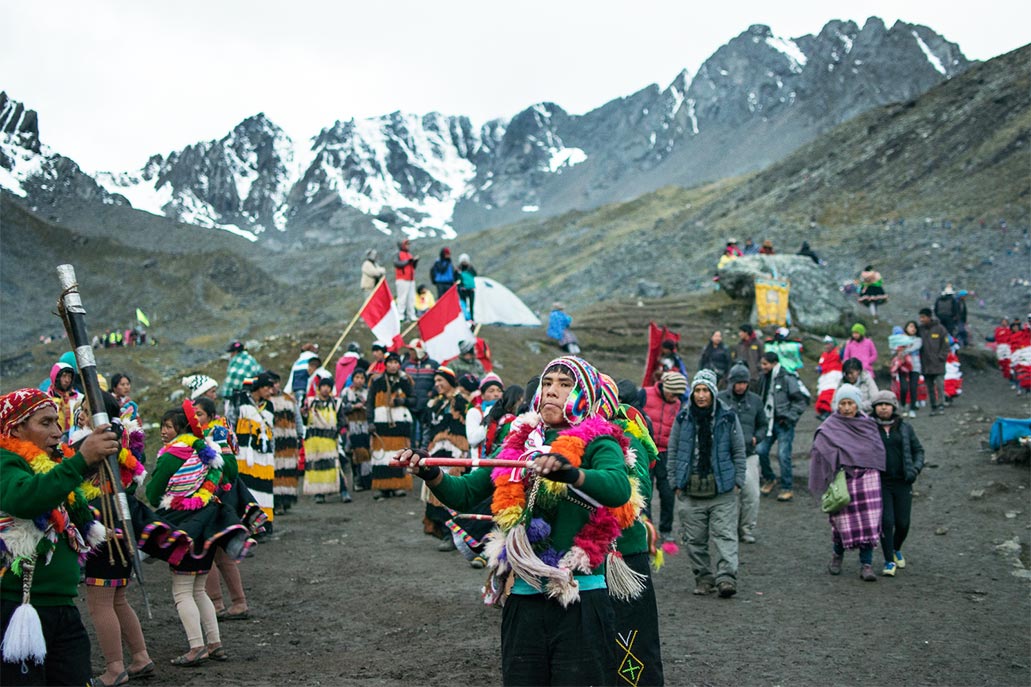
The origins of the lord of Qoyllur Rit’i
- The origins of the festival of the lord of Qoyllur Rit’i are very ancient. It is believed that it began as an indigenous celebration but that it became a religious festival with the Spanish conquest and the imposition of the Catholic Church.
- There is a legend that explains the origin of the Lord of Qoyllur Rit’i as a Catholic expression. This version was compiled by the priest of the town of Ccatcca in the 20th century.
“In 1780 a mestizo boy (Manuel) ran into another indigenous boy (Mariano Mayta) on the heights of the snowy Colquepunku. The two children became very close friends. Suddenly little Mariano’s cattle began to increase. As thanks for the miracle, Mariano’s father decided to buy clothes for Manuel. However, when he appreciated the fabric of his clothing, he realized that it was characteristic of a bishop. The village priest decided to find the boy Manuel. When he managed to find it, it was transformed into an image on a stone. The other boy, Mariano, died immediately. His body was buried under the stone where the image of the child Manuel was found. The natives began to venerate this stone on which the Christian authorities painted a crucified Christ. Today, that image is known as the Lord of Qoyllur Rit’i (Quechua word that means “Snow of stars”) ”.
The pilgrimage at the foot of Mount Ausangate
- The pilgrimage to the Sanctuary of the Lord of Qoyllur Rit’i brings together more than 10,000 parishioners from Cusco, divided into 8 nations or groups according to their origin: Paucartambo, Quispicanchis, Paruro, Acomayo, Chinchero, Urubamba, Canchis and Anta.
- Each nation embarks on its pilgrimage to the icy heights of the town of Mawayani (Ocongate district, Quispicanchis province) accompanied by a cast of musicians and dancers.
- Once in the town of Mawayani, the devotees set out again, although this time along the difficult snow roads at the foot of the Ausangate. There they will arrive at the Sanctuary of the Lord of Qoyllur Rit’i.
The party at the Sinkara Shrine
- At the foot of the Sanctuary of the Lord of Qoyllur Rit’i (Sanctuary of Sinkara) thousands of devotees from all corners of Cusco gather. There the festival is held in honor of the mountains (Apus) and the image of Qoyllur Rit’i.
- The festival is characterized by the presence of dance and music. The main characters are the so-called ‘Ukukus’, ‘Pablitos’ and ‘Pabluchas’ (men – bears that communicate the settlers with the gods of the mountains) who animate the festivals as well as protect the traditions.
- There are many traditions during the festivities in honor of the Lord of Qoyllur Rit’i. One of them is to leave crosses in the snow near the Sinkara Shrine. Likewise, it is also a tradition to collect some ice to take home (it is believed to have healing properties). However, due to global warming, the thaw has prevented this custom from continuing.
- The large number of people has attracted hundreds of merchants who offer candles, tents, coca leaves, food and small representations of cars, bills, houses and other objects to ask with devotion to the Lord of Qoyllur Rit’i.
Meaning of the pilgrimage of the Lord of Qoyllur Rit’i
- The feast of the Lord of Qoyllur Rit’i brings together Christian traditions as well as deeply rooted Andean customs. For example, in addition to honoring the image of the crucified Jesus, the villagers venerate the mountains with ancient Inca rituals.
Gastronomy in Cusco
Cusco, like most of the Andean regions of Peru, offers delicious typical dishes made with potatoes, corn, beans, chuño, quinoa and more. These dishes are consumed in any part of the year, although it is also customary to do so on special festivities such as: timpu in carnivals, chiriuchu in Corpus Christi, etc. There are many restaurants where you can taste traditional Cusco dishes. One of the most popular is the San Pedro market in the Historic Center.
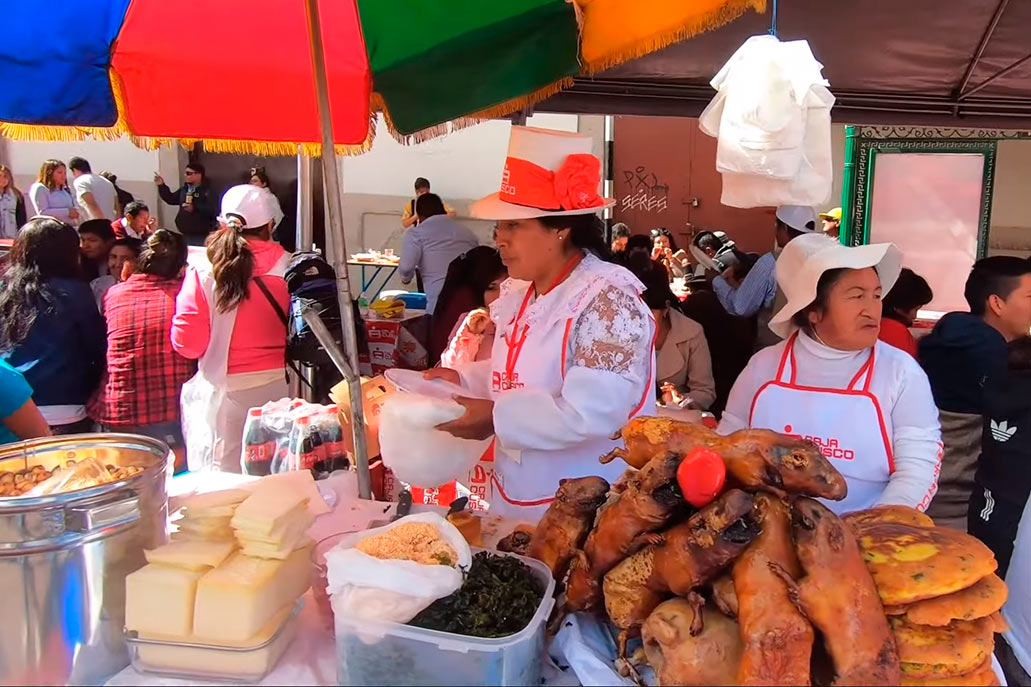
Chiriuchu
- Chiriuchu is a traditional Cusco dish that translated from Quechua means ‘cold chili pepper’.
- As its name indicates, it is a dish that is traditionally eaten cold. Its main ingredients are: guinea pig, chicken, cochayuyo, cheese, chorizo and corn tortilla.
- In Cusco it is tradition to eat Chiriuchu during the ‘Corpus Christi’ festival. It is believed that this is due to the fact that representatives from every corner of the Inca empire honored the Inca with an ingredient typical of their region. Thus, combining all the ingredients, Chiriuchu was created during the ‘Inti Raymi Festival’.
These are the ingredients of Chiriuchu:
- Guinea pigs.
- Hen.
- Celery.
- Turnip.
- Poro.
- Pepper and salt.
- Dried trout egg cup.
- Cochayuyo.
- Court.
- Chorizos.
- Cheese.
- Cecina.
- Rocoto.
- Corn tortilla (egg, corn flour, prepared flour, pumpkin puree, salt, pepper).
Baked suckling pig
- Baked suckling pig is a dish brought by the Spanish to Peru. In Cusco it is a tradition to taste this dish during All Saints’ Day (November 1).
- The name ‘Lechón’ would come from the word ‘Milk’ since the pigs that are prepared for this dish are ‘about to stop lactating’.
- In many provinces of Cusco this exquisite and crunchy dish is prepared. One of the most famous towns for the preparation of ‘Baked Pig’ is Huarocondo in the Anta province.
- In Cusco, the pig is generally accompanied with: humita, moraya, oropesa bread and, on some occasions, baked noodles.
These are the ingredients of the baked suckling pig:
- 1 sucker.
- 4 tablespoons of minced garlic.
- 4 tablespoons of ground chili pepper.
- 5 tablespoons of ground mirasol chili.
- 1 cup of vinegar.
- 2 tablespoons mustard.
- Salt and pepper to taste.
- 1 liter of meat broth.
- 1 large onion.
- 1 tablespoon of cumin.
- 1 tablespoon of ground oregano.
- 1 cup of chicha de jora or lager.
- ½ cup of soy sauce.
Timpu
- The Timpu (also known as ‘Puchero’) is a typical dish of Cusco and the Andean region of Peru based on vegetables and boiled meats.
- It is characteristic to consume Timpu during carnival festivities. In Cusco it is frequent especially during the days of the ‘Comadres’ and the ‘Compadres’.
- The ingredients as well as the preparation varies from region to region. In Cusco it mainly includes beef, lamb, jerky as well as carrots, moraya, corn and more.
These are the ingredients of Timpu:
- Beef.
- Lamb meat.
- Chalona or jerky.
- Garlic cloves.
- Celery.
- Corn.
- Carrots.
- Moraya.
- Cabbage.
- Chickpea.
- Rice.
- Small sweet potatoes.
- Yucca.
- Salt and pepper.
Broad bean kapchi
- The Kapchi of beans is one of the most traditional dishes of Cusco. As its name indicates, it is mainly made up of broad beans, a legume brought with the Spaniards and whose main nutritional characteristic is its abundant fiber.
- There is a variation of bean Kapchi called ‘mushroom Kapchi’, which is made with Andean mushrooms.
- Kapchi de habas is a widely used dish in Cusco due to the low cost of its preparation. It is possible to taste it in the main markets of the city, such as the San Pedro Market or the San Blas Market.
These are the ingredients of the bean Kapchi:
- Broad beans.
- Onion.
- Ground garlic.
- Chili pepper.
- Frozen potatoes.
- Huacatay branch.
- Paico branch.
- Peppermint.
- Fresh cheese.
- Eggs.
- Milk cream.
Baked guinea pig
- Baked guinea pig is a typical dish from the Andes. The main ingredient is cuy (guinea pig), a domestic rodent that was eaten since before Inca times.
- Baked guinea pig is a characteristic dish of the Cusco region and other Andean departments of Peru. In the ancient Inca capital it is common to find ‘cuyerías’, specialized in this dish. The most famous are located in the districts of Tipón and Poroy.
- In Cusco it is characteristic to accompany the guinea pig with baked noodles. Other versions are the cuy chactado and the fried guinea pig.
These are the ingredients of the Baked Guinea Pig:
- Guinea pigs.
- Ground garlic.
- Salt and cumin.
- Pepper.
- Huacatay.
- Yellow pepper.
- Onion.
- Oil.
Chuño cola
- Chuño cola is a characteristic dish of Cusco whose origin dates from Inca times. It is a spicy broth whose main ingredient is chuño (or chuño flour).
- Chuño is the potato dried in the sun by a dehydration process. This food preservation technique was used by the Incas and other cultures of the Andes.
- In Cusco this chuño broth is consumed at any time of the year. The best places to consume the ‘Chuño cola’ are the markets of San Pedro and San Blas.
These are the ingredients of Chuño cola:
- Chicken.
- Onion.
- Broad beans.
- Potatoes.
- Ground chuño.
- Oregano.
By Machupicchu Terra – Last updated, August 28, 2023